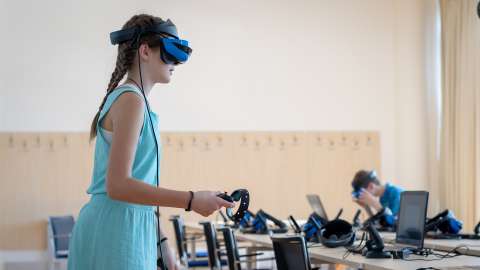What Is Virtual Reality (VR)?
VR is a fully immersive technology where users wear a head-mounted display or headset and experience a computer-generated world of imagery and sounds. With controllers that are connected to a powerful PC, users can manipulate objects and move around in environments that may be otherwise inaccessible to them. With VR, users can see life-size molecules and dinosaurs, visit the Louvre and the Pyramids, or experience a day in the life of an astronaut or heart surgeon.
VR as a Tool for Learning
VR as a learning tool was initially adopted for workplace training scenarios, most notably for flight simulators. With advancements in graphics, spatial audio, animation, and greater accessibility due to lowering entry costs, VR is now being used for a wider variety of use cases, including education. Today, VR can help students engage more deeply with lesson content, practice real-life STEAM skills, and better retain information. In addition, using high-performing PCs with VR can offer an even more immersive learning experience with clear graphics and smooth animation.
Benefits of VR in Education
VR enables active learning, which is a teaching methodology that involves students’ full attention and participation as they learn by “doing” as opposed to learning through alternative passive methods, such as listening to a lecture.
Immersive Active Learning
With VR as a tool for learning, teachers can provide immersive, engaging, technology-enabled experiences for their students. As students learn hands on through VR, teachers can encourage them to use more of their senses to participate in learning activities. For example, students interested in biology and chemistry can explore a virtual, microscopic world, walking among atoms or building molecules by hand. Students who have a passion for history and art can step back in time to view the Great Library of Alexandria or the ceiling of the Sistine Chapel in detail.
Access and Inclusion
With access limited only by the availability of VR-based content, students can engage in experiences that might otherwise be unavailable. Students can take field trips to museums and visit countries on the other side of the world without ever leaving their classroom or incurring the cost of travel.1 Virtual environments can support a range of learning styles and the needs of students with learning challenges. And students with physical limitations can participate in experiences that may not be possible for them in the nonvirtual world.2
Practical STEAM Experiences
VR in schools can also help students who are interested in pursuing STEAM-related careers, enabling them to practice real-life skills before entering the workforce. As employers adapt to industries in the Fourth Industrial Revolution, educators can simultaneously prepare students during their education with VR-based learning. With VR, students can learn the inner mechanisms of a nuclear power plant without ever having to go inside one or identify the parts of a human heart from the perspective of a surgeon without having to step inside a hospital. By allowing students to be visually, audibly, and tactically engaged with specific industries and professions, educators can help give them a clearer idea of what they might experience when they enter the workforce.
Increased Information Retention
When students learn through hands-on activities, they are more likely to retain information. In VR-based learning, students are immersed in three-dimensional virtual environments where they are able to perform and act in targeted, realistic situations. The use of immersive VR-based lessons has been shown to promote improvements in comprehension, cognition, and overall fact retention across a range of subjects and activities, no matter the complexity.3 4
Technologies for VR-Based Learning
When you’re introducing VR in education, there are a number of factors to consider, beyond the headset alone, in order to achieve rich, effective visual learning experiences. While you may think the headset is the most important piece of hardware, delivering an immersive, modern learning environment relies heavily on system responsiveness, graphics, and frame rate. This makes having a high-performing PC with balanced CPUs and GPUs a critical component for delivering better learning experiences.
Choosing a Headset
Depending on the experience you’re looking to deliver, there is a range of available headsets to choose from, in both wired and wireless form, that support PC-based VR learning. Some also support augmented reality (AR) or even mixed reality (MR), allowing students to engage in both physical and virtual environments. In some cases, the headset provider may offer a series of applications for teachers and students to build, create, and share their own VR-based experiences.
The Right PC for VR
Having the right device for VR-based learning is essential. Without high-performing components that allow for fast refresh rates up to 144 Hz, students can actually experience nausea and dizziness because of the increased risk of motion sickness. A PC with an Intel® Core™ i5 or i7 processor with discrete graphics and powerful memory can give students the immersive learning experiences they need and help to reduce motion-related effects as they move or walk around with a headset on.
The Future for VR-Based Learning
Years ago, students would get excited when teachers would roll out the “computer cart” that was stocked with laptops. Soon, teachers will be able to announce the “VR cart” where every student can have access to a VR headset and its respective PC and experience lessons in STEAM unlike ever before. By fueling curiosity and embracing active learning through innovative technologies, VR could measurably change the landscape of education over the next decade.
